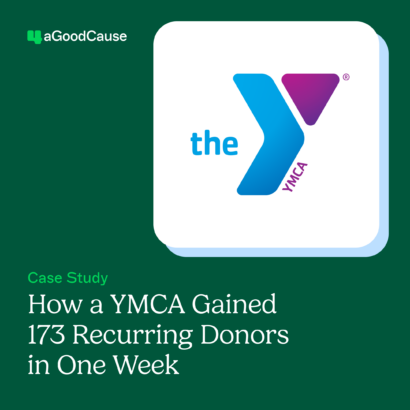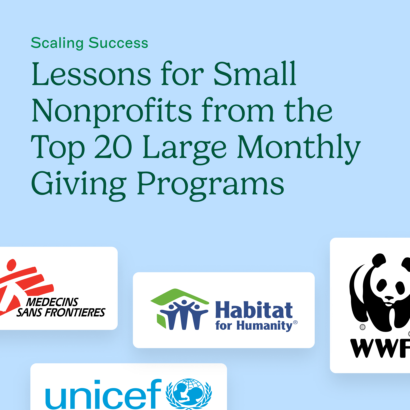Depending on the donor you’re asking, there are multiple ways you can go about requesting donations. With a little preparation, you’ll be set to approach any prospective donor to seek out the funds you need.
There are so many ways you can go about asking for donations, but here are four tips to point you in the right direction.
- Know the donor you’re asking.
- Be specific when asking for donations.
- Present your cause to evoke donors’ emotions.
- Consider what worked (and didn’t work) in the past.
Let’s begin.
Tip #1: Know the donor you’re asking.
Before you can successfully ask for any money, you need to get to know the donor. “Knowing” in this context means more than just having a name in front of you.
You want to be ready to anticipate the most effective solicitation strategy, which will involve understanding a donor’s:
Giving history
Nonprofits should analyze a prospect’s charitable record because it will provide insights into your donor’s giving trends. For example, you can discover their:
- Number of past donations.
- Average donation amount.
- Preferred channel (online, text, direct mail, etc.) for giving.
These three areas work together to determine how you should approach solicitation.
Age
Another useful factor to segment by is donor age. This goes deeper than the incorrect clichés like, “Older donors don’t like being contacted through the internet.” Rather, the correct approach to age segmentation recognizes that donors of similar ages are more likely to have similar interests, online habits, and capacities to donate.
For example, donors fresh out of college are less likely to have the financial means to contribute a major gift. However, they’re likely to be receptive to requests for smaller gifts and donations of time through volunteering.
Estimated Wealth
With the aid of prospect research and/or wealth screening firms, your organization can get closer to accurately modeling a potential donor’s wealth.
Often done in a batch-style analysis of numerous prospects, this process will help you narrow down your list of possible major donors, giving you the background needed to begin the involved process of major gift acquisition.
Interests
First, knowing a donor’s general interests gives you an “in,” or a strategy you can use when requesting donations. You can learn about their hobbies through research (such as simply checking out their social media accounts) and your early conversations.
Keep a record of any key details that you and other members of your nonprofit can use to refresh your memory before any interaction. Additionally, beyond fostering goodwill, the knowledge you gain from your donor’s interests can be used to design a better solicitation strategy.
For example, if your nonprofit provides after-school tutoring to children in impoverished communities and one of your prospective donors is an engineer who has a passion for mathematics, that can direct how you approach your request.
You might tell the story of one of your students receiving a college scholarship to pursue a career in engineering. Or, if you were seeking funding for a project related to math and science, that prospective donor should be at the top your list.
Knowing your donor’s interests will become valuable even after a donation has been made in order to grow a relationship that keeps the donor giving again in the future.
The more background information you have on the donor’s preferences and personality, the better you will understand how to approach asking for donations and what method to use.
In order to make these kinds of decisions, you’ll need to gather ample donor data, either through preliminary prospect research or close analysis of the donors that are already in your CRM.
If you’re struggling with how to research and better understand your prospects, Double the Donation offers a great guide on prospect research tools.
Key point: Knowing who you’re asking sets up the groundwork for how you ask. So do your research!
Tip #2: Be specific when asking for donations.
One of the worst and most common asking strategies is to simply ask, “Will you please donate to my cause,” without first explaining (a) why they should make a contribution and (b) how much they should donate.
The ambiguity of just asking for a donation without any specifics results in a lack of response from donors.
You want to be as direct and specific as possible. Something along the lines of “Would you be willing to donate $50 to help support a boy in need of after-school tutoring?” is more specific and demonstrates an actual need to prospective donors.
With specificity, donors know exactly what you want and why so that they have the opportunity to make an informed decision on whether or not contributing is right for them.
This may seem like too direct of an approach to take, but donors don’t often know how much is needed to operate an after-school program, for example.
Giving them an amount provides your donors the chance to decide if they want to give the amount you requested or give another amount within their means.
Key point: Being specific and direct with donors will let them know exactly what you need so they can make a decision as to what they want to do.
Tip #3: Highlight your cause and mission to connect to donors on an emotional level.
Before you ask for donations, it is a good idea to present your cause. This will give donors a background on what you do and hopefully begin to build initial emotional ties.
Tell the story of your nonprofit’s service. Paint a picture of the impact donations have had in the past and the better future you’re looking to create through increased fundraising.
It’s important that in this storytelling process the focus is on the results and your supporters. In other words, this isn’t a time to congratulate your organization or focus on the “I.”
And, instead of solely focusing on the money, explain what you’ve been able to accomplish and what you’re looking to do, all thanks to the generous help of your supporters.
For example you could:
- Talk about what your volunteers have accomplished.
- Detail any fundraising events that have successfully made an impact.
- Focus on the donor’s value as a supporter.
- Ask supporters to share stories about their experiences with your organization.
However you decide to describe your mission, the goal is to show potential donors how much you value your current donors and that if they do decide to donate, their money will be used responsibly.
Key point: Inspire prospects to want to donate before you ask by speaking to their emotions and describing your cause.
Tip #4: Consider what worked (and didn’t work) in the past.
Did you implement a particularly effective email campaign in the past? Were there any fundraising activities that exceeded your goal? Did a recent strategy fall short?
It’s important to ask questions about your past fundraising strategies. Without understanding what has or hasn’t worked in the past, you can’t properly plan for the future.
How do you track what’s worked and what hasn’t? There are many fundraising metrics that keep track of what communication channels your donors prefer and what asking strategies you need to improve on.
For example, here are two crucial fundraising metrics to record as you ask for donations:
Email conversion rate
In order to measure your conversion rate, you need a goal action and a list of donors to complete the action.
For email, your goal can be how many people opened your correspondence. And then, to take it one step further, how many potential donors, after opening the email, clicked on the call-to-action (making a donation) within.
This will allow you to measure what emails are more successful than others. Perhaps, in one of your campaigns, a lot of potential donors clicked on the email but didn’t take the next step and donate. This may show that while your subject line was compelling, the message inside didn’t resonate with potential donors.
Improving on the parts that didn’t work and keeping the elements that do will help you create better email campaigns in the future.
Online gift percentage via mobile devices
It’s important to start tracking how much of your donations are coming from online channels. This means tracking your nonprofit’s online gift percentage.
Tracking online gift percentage gives you insight into your donor preferences and shows you which channels donors are using. Then, you can take your tracking one step further and measure how much of your online donations come through mobile devices.
Since mobile giving is such a new area of charitable giving, there is still so much to learn. Tracking the donations made on mobile devices and studying this channel of giving sooner rather than later will help your organization get ahead of the learning curve.
Keeping track of these metrics will help you determine whether or not your past fundraising strategies were successful. If your strategies didn’t work in the past, the last thing you want to do is repeat that mistake in the future.
Key point: By measuring the progress of your campaigns, you can determine what needs improvement and make the necessary adjustments for the future.
Asking for donations doesn’t have to be complicated. Know your donor, pitch your cause so that it speaks to the donor’s interests, and track results to avoid repeating past mistakes.
No matter whom you’re asking, from a tech-savvy millennial to a large corporation, use these tips to confidently acquire donations.



